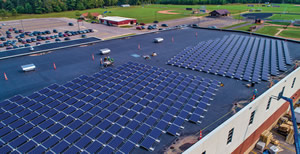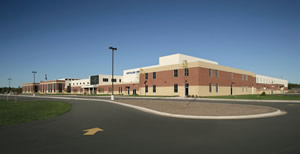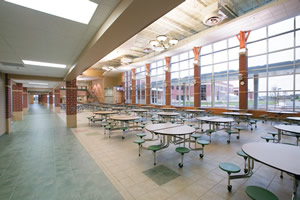Intelligent Buildings
- By Mark Hanson, Jody Andres
- 12/01/17

PHOTO COURTESY OF HOFFMAN PLANNING DESIGN & CONSTRUCTION, INC.
Can you imagine the day when your school building is producing as much energy as it needs? Can you envision that your next school won’t create pollution as it operates? What if your school facility was a significant tool that prepared students for jobs that previous generations couldn’t even imagine? Intelligent buildings are the future!
Buildings are the foremost cause of greenhouse gases (GHG) due to the materials they require and the energy they demand. Architecture 2030—a non-profit organization focused on rapidly transforming the global-built environment from the major contributor of GHG emissions to a central part of the solution to the climate crisis— issued The 2030 Challenge, to drastically reduce the growth rate of GHG emissions. Building and architecture professionals, as well as leaders from a myriad of industries and government entities, are responding. The stage has been set for low-carbon buildings; and schools with sustainability and high-performance attributes are increasingly common place. Zero Net Energy (ZNE) buildings, while still the exception, are anticipated to become the new normal we can all embrace.
School buildings (including new construction, remodeling projects, and existing structures) are rapidly becoming more intelligent—a movement that will continue. An intelligent building is designed to flexibly meet needs and utilize technology and procedures to provide a highly effective learning environment, indoor environmental quality, safety, and efficiency in energy and water use. These smart facilities are designed to provide an optimal learning and working environment for students and staff alike. Additionally, lower operating costs are a great byproduct that administrators and tax payers can all appreciate.
BUILDING INTELLIGENCE

PHOTO COURTESY OF HOFFMAN PLANNING DESIGN & CONSTRUCTION, INC.
Utilizing building intelligence has become increasingly common, including the ability to monitor activities and performance. With today’s technology, adjustments based on monitoring are automatically made and/or manually adjusted to provide a healthier and more productive environment and reduce expenses.
Northland Pines School District’s (NPSD) high school in Eagle River, Wisc., was the first LEED Gold certified public high school in the United States. The 250,000-square-foot facility— now known as the Middle & High School—was innovative at the time of its completion (2006), incorporating many intelligent building features to monitor and fine-tune for optimum comfort, health, and cost savings. Examples include sensors to reduce electric lighting when daylight is sufficient, automatic shut-off lighting when no one is using a specific space, and adjusting heating, cooling, and ventilation to non-occupied settings when no one is present.
The NPSD Middle & High School provides daylighting in almost all classrooms. To take advantage of daylight harvesting, sensors were installed to control the outer row of lights (those parallel to the windows). When sufficient daylight is present, the outer row of lights is turned to 50 percent of output. Motion sensors provide further control. When no one is present, lights are turned off and the HVAC system is set to a non-occupied mode.
EMERGING TRENDS AND HOW TO ENHANCE BUILDING INTELLIGENCE
There are many ways to enhance building intelligence capabilities, whether you’re building a new facility, significantly remodeling an existing structure, or just updating your current property. Sensors and management software are ways that you can quickly and proactively improve operations and reduce facility costs. Emerging opportunities for improvements continue to be introduced, such as demand management strategies to reduce peak demand charges. For example, the direct linkage of the electrical meter to the building control system can provide significant cost savings by selectively limiting chiller operation and/or HVAC fan power as peak demand approaches identified thresholds over the course of the year. Most electric utilities charge their commercial customers, such as school districts, forty to fifty percent of their electric bill cost based on the monthly peak demand in kW (kilo-Watts). Studies have shown that building occupants will typically be unaware of small, short-term temperature adjustments—if they even occur—due to these measures.
This kind of building operation adjustment will be enhanced as utilities introduce smart grids that provide a price signal in real time from the power grid and use that price signal to control the operation of the building’s equipment. If power costs are elevated, such as at peak demand times, non-essential equipment or some lighting can be limited or turned off. Another intelligent feature includes CO2 sensors which control ventilation, providing additional outside air when appropriate.
These types of enhancements require additional programming of HVAC (heating, ventilation, and air conditioning) and lighting controls as well as explicit conversations and training with facilities staff, teachers and students. It’s important to understand how control systems work, and how a community engages in making their environment more productive and efficient.
If a school’s electrical use can be controlled to reduce the demand peaks or kW peaks, it might use the same amount of electricity over the course of the year, but reduce its electricity bill by 10 percent or more. The electric bill at Northland Pines Middle & High School (NPMS/HS) accounts for approximately 70 percent of the school’s energy bill. NPSD recognized this opportunity and designed a plan to limit its peak demands.
Two important emerging trends for schools and other commercial buildings are on-site solar PV (photovoltaic) systems and on-site battery storage. The addition of solar energy at the NPMS/HS and Eagle River Elementary School in 2017 has accelerated the adoption and use of intelligent building capability at NPSD. The goal of the district is to maximize their advantage when solar power is most available, which corresponds to maximum chiller loads. A portion of the expected economic performance of the solar system is based on savings achieved in reducing peak demand in coordination with solar production.

PHOTO COURTESY OF HOFFMAN PLANNING DESIGN & CONSTRUCTION, INC.
Demand management strategies can be utilized to reduce energy costs with or without the adoption of solar. The addition of on-site batteries at schools in the coming years will further accelerate the control of demand peaks. Batteries can be charged during non-peak power times and then utilized during peak usage hours. Increasingly, schools are discovering opportunities to coordinate their utility needs with on-site solar and/or batteries. An additional emerging trend that complements and accelerates solar and battery adoption is the use of third-party investors. Third-party investors leveraging federal tax credits along with local or state incentives where available are making solar investments feasible with little or no upfront or first-cost investments and are immediately cash flow positive. Investments that improve cash flows move decisions on intelligent buildings into the realm of “no-brainers.”
ENGAGING THE HUMAN FACTOR
While sometimes not considered, the culture of the organization and engagement of the users in an intelligent building have a profound impact on success and sustainability. There are various opportunities to improve the quality of our school facilities, impacting both the first cost and operating costs of a project, and enhancing the learning environment.
There is a common tendency to exclude building occupants, and in some respects even maintenance staff, when considering how to optimally design and operate a school. From a financial management standpoint, we’ve been surprised at how many facility managers don’t see monthly utility bills. Even more rare are situations where incentive structures are in place to reward staff for improving indoor building conditions, such as air quality or noise levels, or for reducing the energy bill. Why exclude those that have an important influence on ongoing success?
Unfortunately, it’s also common to omit occupant training regarding how to efficiently and effectively operate thermostats or lights. In classrooms where window treatments such as blinds or shades are provided, it’s common to see blinds shut and all the lights on. The intent of the design is to provide views and daylighting, which may be eradicated by operator error. On the other hand, we’ve likewise seen excellent examples of occupants, who have been trained and empowered in the use of their facility, making wise choices. These choices complement an intelligent building to create a high performing educational environment.
A VISION FOR THE FUTURE
An intelligent school is not just an affordable and sustainable facility moving in the direction of a Zero Net Energy building—it’s a profound learning environment. Schools will progressively be interacting with an intelligent grid that will enable them to optimally procure energy at times and sell energy at others. In many cases, on-site solar systems or battery storage will enable schools to become Zero Net Energy. The curriculum will be integrated to the performance of the various building systems. The school building serves as a platform for STEM (science, technology, engineering, and math) along with environmental systems studies, financial literacy, and political science and government. This is the vision of the 2030 Challenge.
The NPSD is well along the path to this vision. As noted, NPSD recently installed solar PV systems and upgraded the energy management systems at Eagle River Elementary and Northland Pines Middle & High School. The solar PV energy systems have been installed on the fieldhouse roof of the Middle & High School and on the ground behind Eagle River Elementary School. This project integrates demand management with the solar production to reduce cost and make the solar addition cash flow positive (using outside investors and a Wisconsin Focus on Energy Grant) in year one and onwards. As the solar and battery markets continues to mature and as utility regulations keep pace, future financially advantageous investments will enable these schools to become zero net energy.
School districts that continue to push for high performance, and goals such as The 2030 Challenge, will drive new technology. Intelligent buildings are an exceptional way to provide facilities that fulfill educational goals and meet financial demands. With the drive for social change and the value it can have for school operations, it is not a daunting task, but an exciting goal to embrace.
This article originally appeared in the issue of .